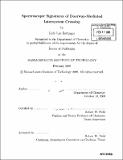Spectroscopic signatures of doorway-mediated intersystem crossing
Author(s)
Bittinger, Kyle Lee
DownloadFull printable version (17.79Mb)
Other Contributors
Massachusetts Institute of Technology. Dept. of Chemistry.
Advisor
Robert W. Field.
Terms of use
Metadata
Show full item recordAbstract
Intersystem crossing in acetylene, C₂H₂, is described by a doorway-mediated model, where singlet-triplet mixing between the first excited singlet~ state, S₁, and the manifold of low-lying T₁,₂ states is controlled by special vibrational levels of the third excited triplet state, T₃. However, the influence of T₃ doorway states on the ~A¹Au <-- ~X¹[sigma]+g spectrum of acetylene is not well characterized for most S₁ vibrational levels. The doorway model is formulated to account for the LIF/SEELEM spectra of S₁ vibrational sublevels that are weakly perturbed by T₃ doorway states. The structure and properties of a doorway-mediated effective Hamiltonian are discussed, and a method for spectral deconvolution is presented for the doorway model. The dependence of fluorescence center-of-gravity on the time delay of a gated integration region is developed as an analysis tool for LIF spectroscopy. Triplet perturbations in the spectra of four S₁ vibrational sublevels are discussed in terms of the doorway model, using this new tool. IR-UV double resonance LIF/SEELEM spectroscopy is used to investigate the role of the torsional and "cis"-bending vibrational modes of S₁ in the promotion of vibrational overlap between levels of S₁ and T₃. A collisional method for the population of metastable molecules in a pulsed supersonic expansion is presented and discussed.
Description
Thesis (Ph. D.)--Massachusetts Institute of Technology, Dept. of Chemistry, 2009. Vita. Includes bibliographical references (p. 229-239).
Date issued
2009Department
Massachusetts Institute of Technology. Department of ChemistryPublisher
Massachusetts Institute of Technology
Keywords
Chemistry.